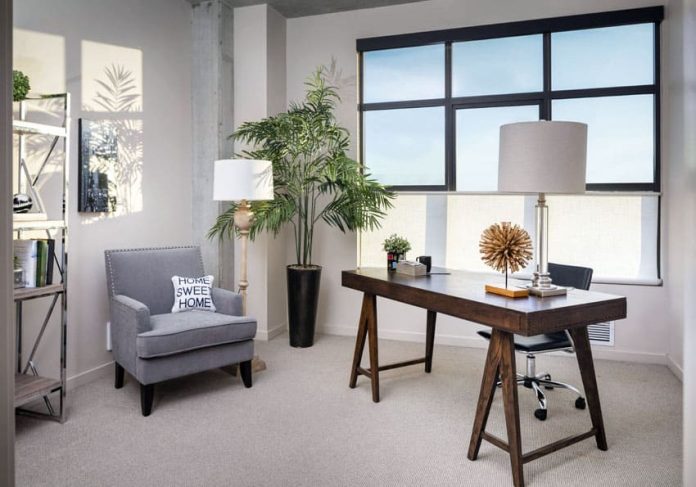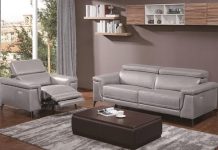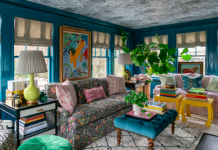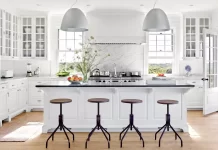Whether you are setting up a new workspace or revamping an existing space, the environment you create can profoundly affect you and your work. Your environment evokes certain psychological aspects, such as how you feel, which shapes and forms an attitude.
Attitude is a powerful force in the work environment and entails performing and responding to those around you, such as co-workers. The interesting thing is that their environment can influence a person’s attitude, and in turn, a person’s attitude can affect their environment.
Someone in a comfortable, calm, and relaxed environment is more likely to have a more positive attitude. A person who has a positive attitude is more likely to view work and co-workers positively. People with a good attitude tend to be more efficient, motivated, productive, and lift up the people around them.
The opposite is also true. Someone in a disorganized, cluttered, and chaotic environment is more likely to be stressed and have difficulty focusing, which leads to more of a negative attitude. A person with a negative attitude is more likely to view work and co-workers negatively. Workers with this attitude tend to be less efficient, less productive, and bring people down with them. Instead of focusing on the task at hand, all focus is on the clutter and mess. All of the positive energy goes down the drain.
Therefore, the goal is to create an organized, peaceful, aesthetically pleasing area to work to bring out and nurture productivity and the best you have to offer.
One way to create this environment is through Feng Shui. This ancient Chinese art uses objects, colors, and material elements to create a natural flow of energy and balance that results in a harmonious environment.
In Feng Shui, five elements affect the flow of energy and balance. These elements include wood, fire, earth, metal, and water. Each element brings a certain type of energy represented by the object, color, or material.
In an office environment, this effect can be achieved by the placement of furniture, colors, and decorations. Here are some decorating ideas to achieve Feng Shui in your work environment.
Placement of Furniture
1. Place the desk in a command position. This means to place your desk so that you can see the door without being directly in line with it. The reasoning for this is so you can see what is coming your way without being in the direct line of fire.
Ideally, this would be somewhere in the middle of the room with nothing close by so that the energy can flow continuously and smoothly all around the one sitting at the desk. The use of a wooden desk is beneficial, too, since it represents natural energy that is strong and stable.
The most important thing is not to have your back facing the door. If you’re in a cubicle, you may not have any control over this placement of your workspace, but you can set a mirror on your desk facing towards the door, so you can see what or who is coming towards you. The mirror is also a great symbol and reminder of self-reflection.
2. Have something solid behind you. This can be the wall, a cabinet, or a large piece of furniture. This will make you feel secure and supported. A desk chair with a high back will also give off a vibe of support.
Decorations
Decorate with items that represent the five elements.
3. Include plants as part of your decor. Bring nature into your office space. Nature tends to have a calming effect. It’s somewhere where you can take a step back and take a deep breath without the stress of a fast-paced world.
Plants are also ideal because they cleanse the air. Plants that can be considered are peace lilies, Chinese money plants, ferns, and bamboo such as lucky bamboo and sweet heart bamboo. Plants represent the element wood. Wood channels growth and creativity.
4. A picture of a mountain never gets old. A picture or painting of a mountain emits energy that represents support and a reminder to stay grounded.
5. Decorate with light and lamps. Plants bring light to the mind. Natural light is the most ideal because it increases mood and productivity. However, if you lack natural light, bring in lamps to fill in. A pottery lamp, for example, could represent the earth element. The element Earth channels stability and strength.
6. A small water fountain makes a nice addition. The element, water, symbolizes flow, emotion, inspiration, and abundance. Water fountains exude a calming, soothing effect that transcends deep into the soul.
7. A metal sculpture draws attention and piques interest. It also keeps you on your toes and motivated since it symbolizes sharpness and precision and channels focus and order.
8. Candles make nice decorations. Candles can channel energy both through sight and smell if scented. Candles represent fire, channeling passion, boldness, transformation, and energy.
9. Experience the environment through your senses with an Essential Oil dispenser. The citrus aroma is calming and relaxing. This scent will transport you off to a tropical island and beach where you can settle your mind.
10. Artwork with a positive mantra will keep you inspired. Include artwork with positive mantras and pictures of people you admire to keep you inspired and continuously reaching for your dreams. Place these decorations in plain sight so you can see them daily.
Colors
Colors will also contribute to the flow and energy captured in your work area.
11. Color can be incorporated by painting the walls or bringing in objects of a specific color.
The following are colors that represent the different elements:
- Green means wood such as plants
- Blue is associated with water
- Brown and tan are indicative of the earth
- Silver and grey symbolizes metal
- Red is associated with fire
The goal is to balance the colors, shapes, and textures. You don’t want too much of any one thing, or you lose the balance. Remember, the journey is towards a peaceful, harmonious environment.
Connect with your inner self and purposely let this aura transcend your environment. Your environment should reflect who you are, the person you want to be, your goals and aspirations.
















